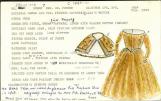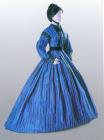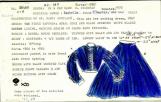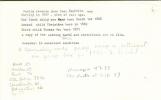1
The genesis of the Costume Museum of Canada dates from 1953 when the first show of vintage costumes, called the 'Fashion Review' was mounted as a project of the Dugald Women's Institute. Between 1959, when the Dugald Ladies Fashion Review became an independent entity and 1977, when the Dugald Costume Collection was incorporated, many people who enjoyed the review were moved to donate not only clothing and accessories but also family photograph collections and other family documents that they wished to see preserved for future generations.2
Winnifred Van Slyck modelling a paisley taffeta dress made in Red River circa 1850.1974
Winnipeg, Manitoba
 Credits:
Credits:Dugald Ladies Fashion Review fonds
Costume Museum of Canada
3
A reminiscence by Dugald Ladies Fashion Review commentator Edna Holland.1983
Dugald, Manitoba
«We have in our collection a beautiful brown paisley taffeta dress made at Red River in 1850. The silk was ordered from Paris. It was 27 inches wide so you can imagine how many yards you would need for a floor length skirt and bodice with long sleeves, as well as a matching cape.»
«Not all styles were accepted without criticism. That paisley gown has quite a low cut neckline and that was a subject of controversy at the time. Some people said it could lead to evil consequences. That dress [also] had something really useful, which was found in most skirts of that time. It was a concealed pocket, in the side seam. These pockets were quite deep and quite inconspicuous; a very good place to carry a fan, your smelling salts...any number of things.»
(Edna Holland fonds. Commentaries Series. Springfield Collegiate Presentation, February 24, 1983)
Credits:Edna Holland fonds.
Costume Museum of Canada
4
Winnifred Van Slyck modelling a pasiley tafetta dress made in Red River circa 1850.Circa 1850
Costume Museum of Canada, Winnipeg, Manitoba, Canada
 Credits:
Credits:Dugald Ladies Fashion Review fonds
Costume Museum of Canada
5
A special feature of this gown is the technique developed in the "Far East" used to produce the interesting 'watery' effect of the paisley design. This technique, known as Ikat dyeing, is related to tie-dying and batik in which the warp (vertical) or (weft) horizontal threads are dyed in the pattern before being woven into fabric. One can only imagine the journey this fabric made, first from Asia to Europe then perhaps by sea to Hudson's Bay and then south by York Boat to Red River.6
Red River Settlement, 18681868
Winnipeg, Manitoba
 Credits:
Credits:Artist: James Lockhart
Library and Archives Canada, Acc No. 1983-100-1
7
Catalogue Card for DEL-1, brown paisley tafetta silk evening gown.1954
Dugald, Manitoba
 Credits:
Credits:Costume Museum of Canada
8
Donated in 1954, this dress was designated as DEL-1 (Dress-Evening-Ladies) according to the cataloguing system developed by Winnifred Van Slyck. Mrs. Van Slyck's conscientious cataloguing of every artefact she received contributed to the value of the collection as a regional cultural and historical asset.Each catalogue created by Mrs. Van Slyck featured a hand drawn and water-coloured illustration done in her own hand.
9
English silk taffeta wedding dress, circa 1867.1867
Costume Museum of Canada, Winnipeg, Manitoba, Canada
 Credits:
Credits:Costume Museum of Canada
10
This cherished artefact became a star of the Fashion Review, providing a vehicle to access the experience of immigrants to Manitoba and the Springfield district as well as 19th century wedding customs. Items also found in the trunk with this dress were Isabella's handmade gold leather slippers and hand knit stockings which she had save from the day of her wedding.11
Catalogue card for DW-59, electric blue silk tafetta wedding gown.1972
Costume Museum of Canada, Winnipeg, Manitoba, Canada
 Credits:
Credits:Costume Museum of Canada
12
Reverse of Catalogue Card for DW-59, electric blue silk tafetta wedding gown.1972
Costume Museum of Canada, Winnipeg, Manitoba, Canada
 Credits:
Credits:Costume Museum of Canada
13
Open robe silk tafetta gown, circa 1765.Circa 1765
Costume Museum of Canada, Winnipeg, Manitoba, Canada
 Credits:
Credits:Costume Museum of Canada